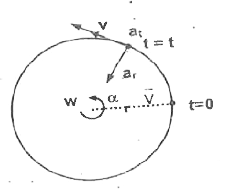A particle starts moving with a constant angular acceleration in a circular path. The time at which the magnitudes of tangential and radial acceleration are equal is
Let the speed of the particle of the particle after time t from starting be v
⇒ the centripetal acceleration, a,=V2r=rω2 & the corresponding angular speed ω=aplˆ
⇒a1=r(αt)2=rα2t2
We know that the tangential acceleration a1=rα since a1=a1 (given)
⇒rα2t2=rα
⇒t=1√α

Topper's Solved these Questions
- KINEMATICSBOOK - FIITJEECHAPTER - KINEMATICSEXERCISE - Problem (objective)
14 Videos
- KINEMATICSBOOK - FIITJEECHAPTER - KINEMATICSEXERCISE - Comprehension (I)
3 Videos
- KINEMATICSBOOK - FIITJEECHAPTER - KINEMATICSEXERCISE - NUMERICAL BASED QUESTIONS DECIMAL TYPE
5 Videos
- HEAT AND TEMPERATUREBOOK - FIITJEECHAPTER - HEAT AND TEMPERATUREEXERCISE - NUMERICAL BASES QUESTIONS
1 Video
- LAWS OF MOTIONBOOK - FIITJEECHAPTER - LAWS OF MOTIONEXERCISE - COMPREHENSION-III
2 Videos
Similar Questions
Knowledge Check
A particle starting from rest moves with a constant angular acceleration α in a circular path. The time at which the magnitudes of tangential and radial acceleration are equal is -
A1αBαC1√αD√αA particle starts with constant angular acceleration of 2 rad/s2 in a circle of radius 4m. Find angle between net acceleration and radial acceleration after 2 s :-
Aθ=tan−1(18)Bθ=tan−1(14)Cθ=tan−1(12)Dθ=tan−1(116)A point mass moves along a circle of radius R with a constant angular acceleration α. How much time is needed after motion begins for the radial acceleration of the point mass to be equal to its tangential acceleration ?
A√1αB√RαC√2αD√12α
A particle is moving with a constant angular acceleration of 4rad/s2 in a circular path. At time t=0 , particle was at rest. Find the time at which the magnitudes of centripetal acceleration and tangential acceleration are equal.
View SolutionA particle is moving along a circular path ofradius R in such a way that at any instant magnitude of radial acceleration & tangential acceleration are equal. 1f at t = 0 velocity of particle is V0. Find the speed of the particle after time t=(R)/(2V0)
View SolutionAngular momentum of a single particle moving with constant speed along circular path :
View SolutionVariation OF Radial and Tangential Acceleration in Circular motion
View SolutionA particle is performing a U.C .M along a circular path of radius r, with a uniform speed v. Its tangential and radial acceleration are
View Solution
